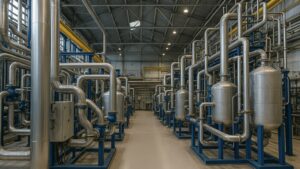The data center industry is rapidly moving towards high-density data center computing. The reason for this is the unquenchable need for data processing and storage. Moreover, the technological landscape is changing. There have been huge advances in high-performance computing, AI, ML, and advanced data analytics. So, this means that old low-density server settings must give way to more compact and power-hungry infrastructures.
As a result, effective capacity planning is essential. It enables high-density data center computing in a sustainable, and energy-efficient way. This article delves into the key strategies and considerations for optimizing capacity planning in the context of high-density data center computing.
Understanding High-Density Data Center Computing Demands
High-density data center computing demands necessitate a fundamental change in data center operations and design. CPU and GPU utilization can give higher power density and heat loads. It can also provide higher memory and storage requirements. Let us understand it in depth:
Power Density Challenges
High-density data center computing equipment can have densities surpassing 30 kW per rack. This is unlike standard data centers, where power densities are typically 5–10 kW per rack. Furthermore, power distribution and cooling systems need to be reevaluated. This is in light of this exponential rise in power density. Moreover, it is important to carefully evaluate factors like higher electrical distribution losses. It also includes problems with circuit breakers and restrictions in rack power distribution units. For high-density power consumption, proactive planning is necessary. It provides redundancy, avoids overloads, and preserves operational resilience.
Thermal Management Complexities
The intense heat produced by high-density data center computing equipment presents difficult thermal management problems. So, it is possible for conventional air-cooling techniques to grow insufficient. In this case, sophisticated liquid cooling systems or creative heat-removal techniques will be required. Furthermore, the high heat densities raise the possibility of equipment failure or thermal shutdowns. As a result, it causes hotspots and inefficient cooling. So, a thorough examination of heat loads, airflow patterns, and thermal dynamics is crucial. It helps in the development and implementation of efficient cooling strategies. These strategies preserve ideal operating temperatures while reducing energy usage.
Assessing Current and Future Capacity Requirements
A thorough evaluation of the present and anticipated future computing demands is the first step toward effective capacity planning. Let’s look at it in-depth ahead:
Workload Profiling and Modeling
Examine the particular workload characteristics. It includes patterns of CPU and GPU utilization, memory footprint, storage demands, and network bandwidth requirements. Furthermore, accurate modeling of resource needs and potential bottleneck detection are made possible by this data-driven methodology. Moreover, tools for profiling, monitoring, and historical use statistics can offer important insights. This is into how different workloads and applications use resources. Tests and benchmarks should also be done. It helps to determine how new workloads and application installations affect resource use.
Scalability and Growth Projections
Engage stakeholders from different business divisions. It helps to learn about their growth strategies, both short- and long-term. Furthermore, estimate future capacity needs based on anticipated rises in workload, newly deployed applications, and developing technologies. It includes artificial intelligence and machine learning. Moreover, work together with product teams, application owners, and business executives. It helps to get information about market prospects, technological roadmaps, and strategic initiatives. These can affect computing demands. Additionally, make use of this data to create capacity forecasting models and schedule in advance for infrastructure additions.
Legacy Infrastructure Integration
Examine the current data center’s power, cooling, and space availability infrastructure. Assess if modifications or replacements are required for outdated systems. Also, see if they can be smoothly integrated with high-density data center computing environments. Furthermore, make thorough evaluations of the present infrastructure’s components’ age, state, and capacity constraints. Moreover, determine any compatibility problems, such as restrictions in the cooling system or power distribution. Also, create plans for migration or mitigation following those findings.
Optimizing Power and Cooling Capacities
The two essential elements that need to be carefully prepared for in high-density computer settings are power and cooling. Let’s see about these aspects ahead:
Right-sizing Power Infrastructure
Perform comprehensive power evaluations to ascertain the suitable capacity. This is for backup generators, UPSs, and power distribution units (PDUs). Moreover, to increase energy efficiency, use intelligent power management techniques. This includes dynamic power capping and high-voltage direct current (HVDC) distribution. Utilise power use effectiveness (PUE) computations and computational fluid dynamics (CFD) modeling. It maximizes energy savings and optimizes power distribution designs. Also, take into account putting in place redundant power routes, intelligent load balancing, and modular power infrastructure designs. It helps to guarantee high availability and scalability.
Advanced Cooling Solutions
Investigate and assess cutting-edge cooling options designed for high-density computer settings. These might consist of:
- Liquid cooling: Rear-door, immersion, and direct-to-chip heat exchangers provide the best heat transfer performance for high-density racks.
- Containment solutions: Contained aisles, also known as hot/cold aisle containment, help isolate and control airflow. It also increases cooling effectiveness and lowers energy usage.
- Free cooling: In conditions that are conducive to it, using water-side or ambient air economizers. It can drastically lower mechanical cooling demands.
- Computational fluid dynamics (CFD) modeling: Use CFD simulations. It helps to detect hotspots, optimize airflow patterns, and create effective cooling arrangements.
Perform in-depth cost-benefit assessments. It helps to determine which cooling solutions are best for your high-density environment. Furthermore, take into account things like energy savings, operating expenses, and performance increases.
Integrated Monitoring and Management
Utilise data center infrastructure management (DCIM) software. It provides real-time power and cooling capacity monitoring and management. Furthermore, proactive capacity planning and optimization are made possible by DCIM systems. It offers visibility into resource use.
Utilise DCIM platforms’ machine learning and predictive analytics features to anticipate capacity needs. It also helps to spot any bottlenecks and allocate resources as efficiently as possible. Furthermore, incorporate DCIM with other facility management tools and building management systems. It provides a comprehensive understanding of data center operations.
Architectural Considerations for High-Density Data Center Computing
The data center’s physical configuration and architecture are essential to the maintenance of high-density data center computing environments. So, let’s know about it more:
Modular and Scalable Design
Adopt a scalable, modular data center design. It enables gradual capacity increases in response to rising computing needs. Furthermore, effective resource provisioning is made possible by modular designs. It also reduces stranded capacity. Moreover, think about prefabricated or containerized data center modules. It can be quickly deployed and scaled to meet requirements. Additionally, provides a scalable and versatile infrastructure that can accommodate different rack densities. This is so that high-density computer zones may be easily integrated into one building.
Rack-level Containment and Cooling
Use rack-level containment systems to effectively separate and remove heat from high-density racks. It includes chimney cabinets or vertical exhaust ducts. Furthermore, examining rack-level cooling options can offer focused, localized cooling for high-density areas. It includes direct-to-chip liquid cooling or rear-door heat exchangers. Optimize the distribution of cooling and uphold the required operating conditions. This is by utilizing rack-level environmental monitoring sensors and controllers.
High-density Zone Segregation
Think about dividing up high-density processing zones. It helps to maximize cooling and electricity distribution within the data center. This strategy simplifies operations and maintenance. This is while enabling targeted infrastructure upgrades. Furthermore, a room or section designated for high-density data center computing should have specialized cooling and power distribution systems. It can help manage the high loads. Additionally, put in place physical barriers to separate high-density areas. It is also to stop hot air from recirculating. This includes partitions or containment walls.
Operational Practices for Capacity Management in Data Centers
Robust operational procedures and rules are necessary. It helps in effective capacity management in data centers, which is a continuous activity. Let’s know about it more:
Capacity Monitoring and Forecasting
Keep an eye on how much power, cooling, network, and storage are being used at all times. Use forecasting and predictive analytics techniques. It helps to foresee capacity shortages and schedule expansions or improvements promptly. Furthermore, use dashboards and alerts for real-time monitoring. It helps to proactively spot abnormalities or capacity limits. Moreover, utilize capacity planning tools in conjunction with monitoring data. It provides precise projections that take into account workload patterns. It also includes past trends and anticipated growth scenarios.
Capacity Management Policies
Provide precise rules and regulations for capacity management, such as lead times for capacity additions. It also includes decommissioning or consolidation criteria, and thresholds for capacity utilization. Furthermore, establish service level agreements (SLAs) for capacity management and resource provisioning. It helps to guarantee a dependable and consistent supply of computing services. Put change management procedures in place. It guarantees that decisions on capacity planning are recorded, examined, and authorized before execution.
Cross-functional Collaboration
Encourage cooperation between the operations, facilities, and IT departments. It guarantees a comprehensive strategy for capacity planning. Furthermore, cross-functional capacity management committees and regular stakeholder meetings can help. This is with efficient decision-making and communication. To overcome capacity-related obstacles, promote information exchange and cooperative problem-solving. Assign precise roles and duties to capacity management activities. It includes data gathering, analysis, forecasting, and execution.
To Sum Up
Capacity planning becomes a crucial success element as data centers adopt high-density data center computing. It helps to serve cutting-edge technologies like AI, ML, and HPC. Organizations can guarantee the energy efficiency, dependability, and sustainability of their high-density computing environments by following the elements covered in the article.
To stay ahead of the curve and learn from industry experts, attend the Energy Efficiency for Data Centers Summit on May 16-17, 2024, in Dallas TX, USA. This premier event will explore cutting-edge strategies, technologies, and best practices for maximizing operational efficiencies and sustainability while minimizing energy costs and emissions in high-density data center computing environments. Register now!





